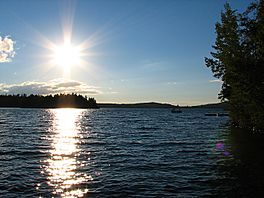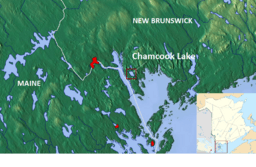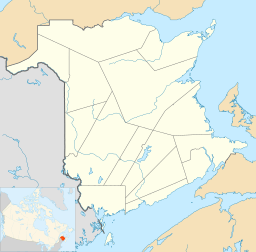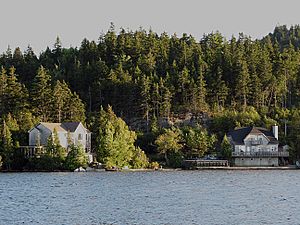Chamcook Lake facts for kids
Quick facts for kids Chamcook Lake |
|
|---|---|
 |
|
 |
|
| Location | Saint Andrews Parish, New Brunswick, Canada |
| Coordinates | 45°08′41″N 67°05′27″W / 45.14472°N 67.09083°W |
| Surface area | 337 hectares (830 acres) |
| Average depth | 60 feet (18 m) |
| Max. depth | 137 ft (42 m) |
| Surface elevation | 29 metres (95 ft) |
| Islands | Odell Island; Big Rock |
Chamcook Lake is a beautiful lake found in New Brunswick, Canada. It's located just north of Passamaquoddy Bay, which is part of the famous Bay of Fundy. This area is very close to the border with Maine in the United States.
The small town of Chamcook, New Brunswick sits on the eastern side of the lake. Nearby, you'll also find Chamcook Mountain. For a long time, Chamcook Lake has been well-known in both New England and Canada for its excellent fishing.
Contents
What Does "Chamcook" Mean?
The name "Chamcook" comes from the Passamaquoddy language. The original word is K'tchumcook.
According to a historian named William Francis Ganong, this word has several possible meanings. However, no one is completely sure which meaning is the correct one.
Exploring Chamcook Lake's Geography
Chamcook Lake is about 1.5 miles (2.4 kilometers) away from Passamaquoddy Bay. You can easily reach the lake by road from St. Stephen, New Brunswick. There was even a train station for freight services at Chamcook Lake in the past.
The lake sits about 95 feet (29 meters) above sea level. It can get quite deep, reaching a maximum depth of 200 feet (61 meters). The Chamcook River flows into the lake, starting from the cone-shaped Chamcook Mountain.
On the lake, you'll find two islands: Odell Island in the southeast and Big Rock in the north. Even though it's called "Big Rock," Odell Island is actually larger! About 2.2 miles (3.5 kilometers) north of Big Rock is a smaller lake called Little Chamcook Lake.
The water from Chamcook Lake is very important. It provides drinking water for several groups and places. These include the Atlantic Salmon Federation and the St. Andrews Biological Station. It also supplies water to the Champlain Industrial Park and the town of St. Andrews.
Rocks and Mountains Around the Lake
The rocks around Chamcook Lake have a reddish-brown color. They are made of a type of rock called feldspathic and look like syenite. These rocks often turn a brick-red color when exposed to the weather.
On the western shore, there are also very dark, almost black rocks. They have a slight purplish tint.
The tall and lonely Chamcook Mountain stands overlooking the lake. The top of the mountain is rounded and has long scratches. These marks show that a huge glacier once moved across the mountain from the north. Both Chamcook Lake and Chamcook Mountain are part of a large area of sandstone rocks. This area also has fossils and rocks formed by volcanoes.
Lake Health and Ecology
In September 2010, there was a warning about a bloom of blue-green algae in the lake. Officials checked the town's drinking water, which comes from the lake. Luckily, no harmful toxins were found. However, monitoring of the water supply continued to ensure safety.
Animals and Plants of Chamcook Lake
Chamcook Lake is home to many different kinds of plants and animals.
You can find small snails called Vitrea in the lake. In the 1930s, a new type of tiny water flea, called Holopedium, was discovered here. Another type of snail, Lymnaea, lives mostly along the edges of the lake.
Many aquatic plants grow along the lake's margin. These include Isoetes echinospora, Sagittaria montevidensis, Potamogeton gramineus, and Potamogeton spirillus. You can also find the water form of Hypericum boreale. On the dry banks of the lake, a plant called Ground Cedar grows.
Along the lake's edges, you might see plants like Sagittaria latifolia, Sagittaria cuneata, and Acorus calamus. Different types of ferns also grow on the lake's shores and along the stream that flows from the lake to the sea. These include Diphasiastrum complanatum and Diphasiastrum digitatum.
Fish in the Lake
Chamcook Lake is known for its fish. In 1886, about 200,000 young salmon and salmon trout were released into the lake.
Today, fish species found in the lake include sockeye salmon, steelhead trout, and brown trout. At certain times of the year, there are many sebago salmon in the lake.
In the early 1970s, scientists studied the amount of methylmercury in eels from Chamcook Lake. They found higher levels of mercury in the lake's ecosystem. However, brook trout from the lake had very low levels, only 0.03 ppm.




